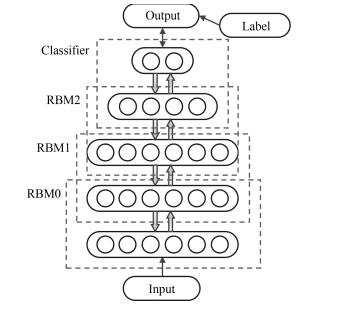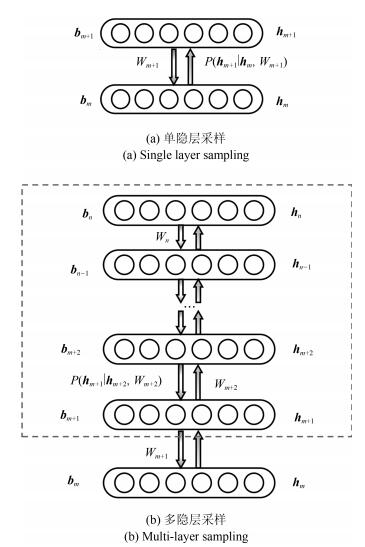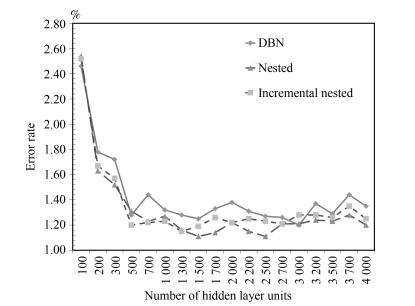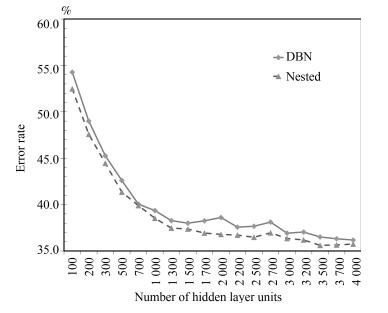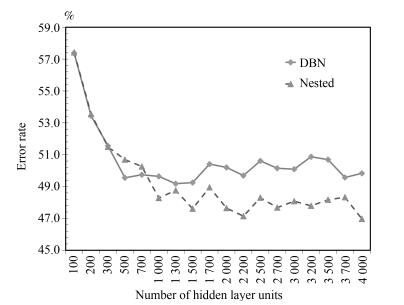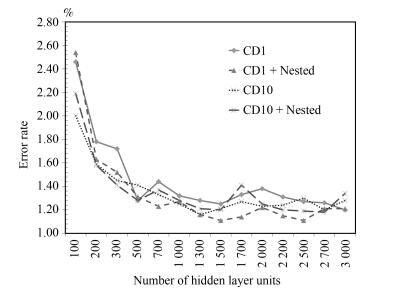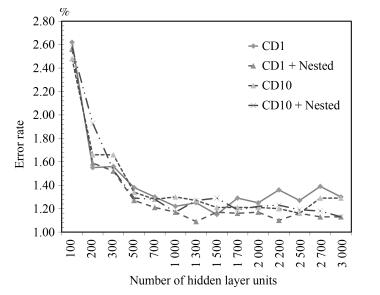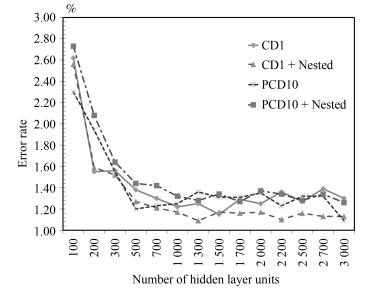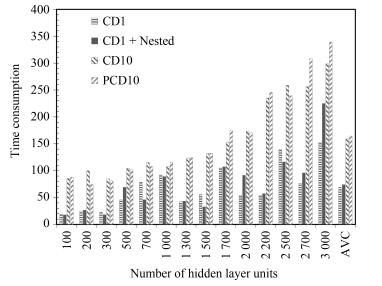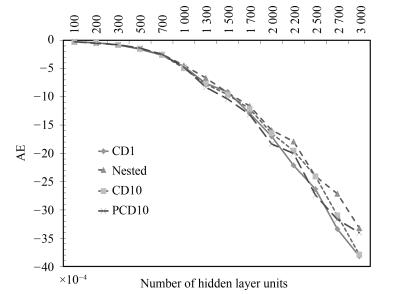|
[1]
|
Bengio Y. Learning deep architectures for AI. Foundations & Trends in Machine Learning, 2009, 2(1):1-127 http://d.old.wanfangdata.com.cn/OAPaper/oai_arXiv.org_1206.5538
|
|
[2]
|
Hinton G E, Salakhutdinov R R. Reducing the dimensionality of data with neural networks. Science, 2006, 313(5786):504-507 doi: 10.1126/science.1127647
|
|
[3]
|
Lee H, Grosse R, Ranganath R, Ng A Y. Unsupervised learning of hierarchical representations with convolutional deep belief networks. Communications of the ACM, 2011, 54(10):95-103 doi: 10.1145/2001269
|
|
[4]
|
Goh H, Thome N, Cord M, Lim J H. Learning deep hierarchical visual feature coding. IEEE Transactions on Neural Networks and Learning Systems, 2014, 25(12):2212-2225 doi: 10.1109/TNNLS.2014.2307532
|
|
[5]
|
Mohamed A R, Dahl G E, Hinton G. Acoustic modeling using deep belief networks. IEEE Transactions on Audio, Speech, and Language Processing, 2012, 20(1):14-22 doi: 10.1109/TASL.2011.2109382
|
|
[6]
|
Sarikaya R, Hinton G E, Deoras A. Application of deep belief networks for natural language understanding. IEEE/ACM Transactions on Audio, Speech, and Language Processing, 2014, 22(4):778-784 doi: 10.1109/TASLP.2014.2303296
|
|
[7]
|
段艳杰, 吕宜生, 张杰, 赵学亮, 王飞跃.深度学习在控制领域的研究现状与展望.自动化学报, 2016, 42(5):643-654 http://www.aas.net.cn/CN/abstract/abstract18852.shtmlDuan Yan-Jie, Lv Yi-Sheng, Zhang Jie, Zhao Xue-Liang, Wang Fei-Yue. Deep learning for control:the state of the art and prospects. Acta Automatica Sinica, 2016, 42(5):643-654 http://www.aas.net.cn/CN/abstract/abstract18852.shtml
|
|
[8]
|
Wu F, Wang Z H, Lu W M, Li X, Yang Y, Luo J B, et al. Regularized deep belief network for image attribute detection. IEEE Transactions on Circuits and Systems for Video Technology, 2017, 27(7):1464-1477 doi: 10.1109/TCSVT.2016.2539604
|
|
[9]
|
Wang B Y, Klabjan D. Regularization for unsupervised deep neural nets. In: Proceedings of the 31st AAAI Conference on Artificial Intelligence. San Francisco, CA, USA: AAAI, 2017. 2681-2687
|
|
[10]
|
Goh H, Thome N, Cord M, Lim J H. Top-down regularization of deep belief networks. In: Proceedings of the 26th International Conference on Neural Information Processing Systems. Lake Tahoe, Nevada, USA: ACM, 2013. 1878-1886
|
|
[11]
|
李飞, 高晓光, 万开方.基于动态Gibbs采样的RBM训练算法研究.自动化学报, 2016, 42(6):931-942 http://www.aas.net.cn/CN/abstract/abstract18884.shtmlLi Fei, Gao Xiao-Guang, Wan Kai-Fang. Research on RBM training algorithm with dynamic Gibbs sampling. Acta Automatica Sinica, 2016, 42(6):931-942 http://www.aas.net.cn/CN/abstract/abstract18884.shtml
|
|
[12]
|
乔俊飞, 王功明, 李晓理, 韩红桂, 柴伟.基于自适应学习率的深度信念网设计与应用.自动化学报, 2017, 43(8):1339-1349 http://www.aas.net.cn/CN/abstract/abstract19108.shtmlQiao Jun-Fei, Wang Gong-Ming, Li Xiao-Li, Han Hong-Gui, Chai Wei. Design and application of deep belief network with adaptive learning rate. Acta Automatica Sinica, 2017, 43(8):1339-1349 http://www.aas.net.cn/CN/abstract/abstract19108.shtml
|
|
[13]
|
Hinton G E, Osindero S, Teh Y W. A fast learning algorithm for deep belief nets. Neural Computation, 2006, 18(7):1527-1554 doi: 10.1162/neco.2006.18.7.1527
|
|
[14]
|
Salakhutdinov R, Murray I. On the quantitative analysis of deep belief networks. In: Proceedings of the 25th International Conference on Machine Learning. Helsinki, Finland: ACM, 2008. 872-879
|
|
[15]
|
Hinton G E. A practical guide to training restricted Boltzmann machines. Neural Networks: Tricks of the Trade. Berlin, Germany: Springer, 2012. 599-619
|
|
[16]
|
Salakhutdinov R, Hinton G. Deep Boltzmann machines. In: Proceedings of the 12th International Conference on Artificial Intelligence and Statistics. Florida, USA: PMLR, 2009. 1967-2006
|
|
[17]
|
Vincent P, Larochelle H, Lajoie I, Bengio Y, Manzagol P A. Stacked denoising autoencoders:learning useful representations in a deep network with a local denoising criterion. The Journal of Machine Learning Research, 2010, 11:3371-3408 https://dl.acm.org/citation.cfm?id=1953039
|
|
[18]
|
Nielsen M. Neural Networks and Deep Learning. Determination Press[Online], available: http://neuralnetworksanddeeplearning.com, February 9, 2018.
|
|
[19]
|
Tieleman T. Training restricted Boltzmann machines using approximations to the likelihood gradient. In: Proceedings of the 25th International Conference on Machine Learning. Helsinki, Finland: ACM, 2008. 1064-1071
|
|
[20]
|
Tieleman T, Hinton G. Using fast weights to improve persistent contrastive divergence. In: Proceedings of the 26th Annual International Conference on Machine Learning. Montreal, Quebec, Canada: ACM, 2009. 1033-1040
|
|
[21]
|
Abdel-Hamid O, Deng L, Yu D, Jiang H. Deep segmental neural networks for speech recognition. In: Proceedings of the 14th Annual Conference of the International Speech Communication Association. Lyon, France: International Speech and Communication Association, 2013. 1849-1853
|
|
[22]
|
Bengio Y, Thibodeau-Laufer É, Alain G, Yosinski J. Deep generative stochastic networks trainable by backprop. In: Proceedings of the 31st International Conference on Machine Learning. Beijing, China: JMLR, 2014. 226-234
|
|
[23]
|
Wang X S, Ma Y T, Cheng Y H. Domain adaptation network based on hypergraph regularized denoising autoencoder. Artificial Intelligence Review, DOI: 10.1007/s10462-017-9576-0
|




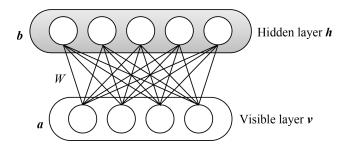
 下载:
下载:
